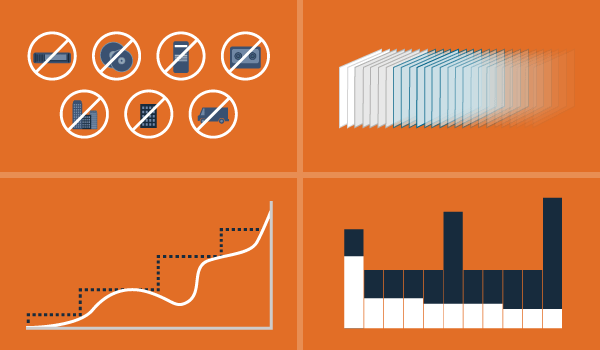The beauty of the SaaS model is that it is easy for organizations to consume and use cloud offerings as well as enables the vendors to realize new levels of agility in their product development. The model is also ushering new innovation that has nothing to do with technology and instead provides for new ways to license and consume software with greater simplicity and at lower costs.
Flashback a decade and you’ll recall that most software licensing was based on a perpetual licensing model, which, in many cases, is still the norm today. Organizations would buy a license to use software indefinitely and pay for support that included new version upgrades through an annual support contract. When the software as a service (SaaS) subscription model emerged it changed the way organizations consume and use software. With SaaS, customers are able to license software on a subscription basis, typically monthly or annually, and gain always-on access to the latest features and support. They are also able to scale license up and down as required and typically gain greater budgeting predictability as they transition from CapEx to OpEx.
Despite the transition to today’s software subscription model, most enterprise SaaS software vendors remain locked into a licensing model based on the number of users, number of servers or other criteria that serve as a proxy for usage rather than actual consumption. As a result, companies often license services based on forecasted usage, paying well in advance for capacity they ultimately don’t need. This can result in consistent over-payments.
The Fundamentals of Consumption-Based Pricing
Consumption-based pricing is evident in utility pricing – just look at your home electric power bill or your mobile phone plan. The bill you receive for these services is based on what you actually consume, not anticipated consumption. In the case of the mobile phone plan, if you don’t fully use the service you’ve paid for, your plan “rolls over” to the next period so you can eventually use it. Consumption-based billing allows users to pay only for what they truly consume, eliminating wasted, over-provisioned capacity reservations. This model is especially useful for data protection expense planning since a company’s annual backup budget must account for the data growth that will occur during that period.
Despite its obvious benefits to users, a true consumption-based model is a rarity in the enterprise software space. A unique exception to this is Amazon Web Services (AWS), which is built on the principals of a consumption model and charges customers based on IO compute used, storage and other actual consumed resources.
Technology Innovations Spur New Pricing Models
Given customer demand for more flexible and cost-efficient pricing, why aren’t all vendors offering consumption-based pricing? Legacy models, which lack storage efficiencies, are essentially forced to recoup their costs through complex pricing models that may provide inexpensive up-front storage but impose stiff penalties when customers need to retrieve data in the event of a disaster or emergency. Likewise, complicated pricing models may apply storage limitations on data retention and force customers to follow their vendor’s retention model or pay more than expected.
In contrast, technology innovations pioneered by Druva have given rise to consumption-based pricing by generating efficiencies and costs savings that can be passed along to customers. Specifically, the technology framework encompassed by Druva Phoenix – the industry’s first all-in-one public cloud offering for server/VM backup, archival and disaster recovery – includes the following:
- No Hardware, Software or Maintenance – By minimizing the backup and archival storage footprint, Druva eliminates the need for expensive hardware and data center facilities. There is no upfront hardware, no more confusing licenses or maintenance, and no need to staff up (especially in remote locations). No hardware also means no complex, expensive, three-year upgrade cycles. The cloud scales without limits and upgrades are seamless to end users.
- Global Deduplication – Druva’s patented, client-based global deduplication provides the industry’s most granular and complete data reduction. By eliminating data redundancy across all users, global deduplication can deliver high-speed, lightweight backups while reducing the data footprint by 50 to 100 times, in many cases, and minimizing the overall storage footprint.,
- Auto-Archiving in the Cloud – Druva’s auto-archival capabilities further reduce overall costs by automatically moving infrequently accessed data to affordable cold storage while keeping warm data available for instant restores.
Druva Phoenix Brings Consumption-Based Pricing to the Real World
Druva recently announced a true “pay-only-for-what-you-use” consumption-based pricing model for Phoenix. This transparent and cost-efficient pricing structure realizes the potential of cloud-based SaaS so that customers don’t overpay for storage they don’t use. With this new offering, Druva is among only a few enterprise software vendors to adopt true consumption pricing.
Pricing for Druva Phoenix is based solely on target storage consumed on AWS. Through our cutting-edge technology, we can take your ever-growing and changing source files and turn 10 TB into 2 TB. Even better, you’ll only be paying for those 2TB. While this varies based on file type, change rate, and number of locations, some customers have reported up to 40 times less capacity used.
With this new approach, businesses can still estimate their storage usage and simply roll over any unused consumption to the next period. Customers can also add additional storage whenever needed. The pricing structure is transparent, with no hidden fees or retention limitations, and takes the guesswork out of pricing and sizing ever-changing storage needs.
Learn more about Druva’s consumption-based pricing and how it can lead to unprecedented cost savings for your organization.
We also invite you to take our Storage Consumption Challenge available through June 30, 2016. We’re so confident that our technology can reduce your overall backup storage footprint by more than half, we’ll give you a $100 Amazon gift certificate if we can’t. Restriction apply. See offer for further details.



